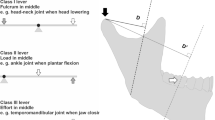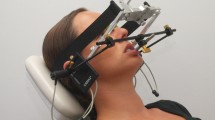Abstract
The Pantographic Reproducibility Index (PRI) has been developed to evaluate mandibular dysfunction through the reproducibility of lateral border movements. There exist no data on the Japanese population regarding PRI. The purpose of this study is to determine the normal range of PRI in normal subjects. Those data will be compared to the patient data and an evaluation of the treatment outcome. Ten male and ten female Japanese who reported no signs and symptoms of Craniomandiubular Disorders were used in this study.
-
1.
The average PRI in males was 6.95 (5.93). In females the average was 7.30 (4.45). There was no statistical difference between sexes.
-
2.
One male subject showed a PRI at 25 and was classified to the slight dysfunction category suggested by Clayton where as other 19 subjects were classified as normal.
-
3.
Within the 24 divided section, the largest PR value was 2 and average varies from 0.03 (saggittal orbiting path early part) to 0.58 (saggittal rotating path later part).
Similar content being viewed by others
References
McNeill C: Temporomandibular Disorders Quintessence Chicago 1993
Tanaka TT: TMD and restorative dentistry 5th ed., Clinical Research Foundation, California, 1995.
Clayton JA, Kotowicz WE and Myers GE: Graphic recordings of mandibular movement: Research criteria. J Prosthet Dent,25: 287–298, 1971.
Clayton JA, Kotowicz WE and Zahler JM: Pantographic tracings of mandibular movement and occlusion. J Prosthet Dent,25: 389–396, 1971.
Roura N and Clayton JA: Pantographic records on TMJ dysfunction subjects treated with occlusal splints, A progress report. J Prosthet Dent,33: 442–453, 1975.
Clayton JA, Crispin BJ, Shields JM and Myers GE: A pantographic reproducibility index (PRI) for detection of TMJ dysfunction, IADR abstract 161, 1976.
Shields JM, Clayton JA and Shidledecker LD: Using pantograph tracing to detect TMJ and muscle dysfunction. J Prosthet Dent,39: 80–87, 1978.
Crispin BJ, Myers GE and Clayton JA: Effect of occlusal therapy on pantographic reproducibility of mandibular border movements. J Prosthet Dent,40: 29–34, 1978.
Beard CC and Clayton JA: Effect of occlusal splint therapy on TMJ dysfunction. J Prosthet Dent,44: 324–335, 1980.
Clayton JA: A pantographic reproducibility index for use in diagnosing temporomandibular joint dysfunction: A report on research. J Prosthet Dent,54: 827–931, 1985.
Clayton JA and Beard CC: An electronic computerized pantographic reproducibility index for diagnosing temporomandibular joint dysfunction. J Prosthet Dent,55: 500–505, 1986.
Mongini F: Factors influencing the pantographic tracings of mandibular movements. J Prosthet Dent,48: 585–598, 1982.
Guichet NF: Procedures for occlusal treatment, Denar California, 1969.
Clayton JA: Personal Communication, 1985.
Author information
Authors and Affiliations
Rights and permissions
About this article
Cite this article
Hatano, Y., Marumo, Y., Tage, T. et al. Pantographic reproducibility of mandibular border movements in subjectively normal subjects. Shigaku = Odontology 85, 449–454 (1997). https://doi.org/10.1007/BF03039041
Issue Date:
DOI: https://doi.org/10.1007/BF03039041




